|
Could Your Facility's Beds Contribute to Entrapment?
Entrapment can happen in the blink of an eye and its consequences can be serious, even fatal. Between January 1, 1985 and January 1, 2013, the FDA was notified of 901 incidents of people becoming caught, trapped, entangled or strangled in healthcare beds. Of these incidents, 531 resulted in death, 151 led to nonfatal injuries and 220 required staff to intervene in order to prevent injuries. The majority of the individuals were frail, elderly or confused.1
To help combat entrapment, the FDA and Hospital Bed Safety Workgroup collaborated to draft guidance for healthcare facilities on developing bed safety programs. The guidelines recommend using a multi-faceted approach that includes evaluating bed design, performing clinical assessment and monitoring, meeting the needs of vulnerable residents and seeking input from product manufacturers as well as facility staff.2
Here are some questions to ask yourself when evaluating the beds in your facility for entrapment risk:
- "Are some components worn?" For example, do rails wobble, have the rails been damaged, is the mattress softer than it should be? These can increase entrapment risk.
- "Does the bed still have its original parts?" Many beds that are currently in use do not have their original mattresses or bed rails. The risk of entrapment is increased if there are gaps or spaces between the components of the bed system, which can happen when pieces are replaced or removed.
- "Have I contacted my supplier to see if any entrapment-preventing accessories are available?" These could include mattresses, rails and other accessories.
- "Is the mattress the correct size for the bed?" Not all beds and mattresses are interchangeable.
The FDA has a number of resources available on preventing entrapment at your facility. To view them, click the link above.
Reference
1 U.S. Food and Drug Administration. Hospital Beds. Available at: http://www.fda.gov/MedicalDevices/ProductsandMedicalProcedures/GeneralHospitalDevicesandSupplies/HospitalBeds/default.htm. Accessed December 4, 2013.
2 U.S. Food and Drug Administration. Hospital Bed System Dimensional and Assessment Guidance to Reduce Entrapment. Available at: http://www.fda.gov/downloads/MedicalDevices/DeviceRegulationandGuidance/GuidanceDocuments/
ucm072729.pdf. Accessed December 4, 2013.
| |









